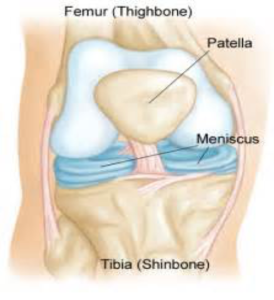The knee is the largest joint in the body. Because it plays an important role in stabilizing, supporting, and moving the lower body, any injury or medical condition that affects the knee can affect a patient’s mobility. One of the most common medical conditions that affects the knee is osteoarthritis (OA). In order to effectively treat OA, an orthopedic specialist must first make the diagnosis of osteoarthritis.
Related Knee Anatomy
Illustration 1- The knee joint
The knee is made up of the femur (thigh bone), tibia (shin bone), and knee cap (patella). The bones are connected to each other by ligaments. Muscles are attached to the bones by tendons. Each end of the bones is coated with a layer of protective hyaline cartilage and shock absorbers made up of rubbery fibro cartilage known as menisci sit between the femur and tibia. In order for the knee to function properly, the above-mentioned structures need to be intact and healthy and there needs to be adequate space maintained between the bones.
Classifying Knee Arthritis
Osteoarthritis is a chronic condition that causes bone, cartilage, and ligaments to deteriorate, become worn, and subsequently become irritated and inflamed. When the cartilage deteriorates on the end of the bones, raw bone, which has nerve endings, becomes exposed and results in pain, especially with weight bearing or impact activities. When an orthopedic specialist diagnoses knee osteoarthritis, they classify it based on its severity using a standing weight bearing x-ray and possibly an MRI. The following findings help the specialist classify the extent of knee arthritis:
- Joint space narrowing. Measurements of the joint spaces are taken in millimeters.
- Osteophyte presence. The number and size osteophytes, which are bone spurs or growths that occur due to the deterioration of cartilage and bone, is taken into account.
- Bone loss. Bone loss indicates arthritis has reached a severe stage.
- When the arthritis progresses to the point that the knee becomes bow legged or knock need
Once arthritis is classified as mild, moderate, severe, or very severe, it can be treated accordingly.
Treating Knee Arthritis
Non-surgical treatment options that may be used to treat knee arthritis include the following:
- Activity modification. Slowing down or limiting impact and load bearing activities helps calm the inflammation and subsequently decrease the pain associated with arthritis.
- Nonsteroidal anti-inflammatory medications (NSAIDs). Over-the-counter and prescriptions medications that work by decreasing inflammation and subsequently the
- Injections- consisting of corticosteroids or hyaluronic acid (synthetic joint fluid) may alleviate the stiffness and pain associated with osteoarthritis
- Physical therapy. Strengthening the muscles of the lower extremity helps take pressure off the knee joint and worn cartilage, which improves function and decreases pain.
When the pain, stiffness, and immobility associated with knee arthritis does not improve or gets worse, surgery may be recommended. A total knee arthroplasty (TKA) is a surgical procedure used to remove arthritic bone and replace it with metal and plastic components. Following a TKA, knee joint anatomy and function are restored.
Seeking Treatment for Knee Arthritis
Diagnosing and treating osteoarthritis of the knee as soon as possible will help to alleviate the debilitating pain and thus improve your ability to get around and do the things you like to do. If knee arthritis is affecting your quality of life, please don’t hesitate to contact our office in either Mahwah and Clifton, NJ to arrange an appointment. We will provide you with the solution you’ve been looking for and with the right treatment program, a reduction in pain and improvement in mobility is entirely possible.
Dr. Nicholas Alexander is the founder of Mahwah Valley Orthopedic Associates and a Board Certified Orthopedic Surgeon specializing in both the surgical and non-surgical treatment of hip and knee conditions. Dr. Alexander completed his Fellowship in Adult Reconstruction and Reconstructive Surgery of the Hip and Knee at the Johns Hopkins School of Medicine and has over two decades of experience. He also serves as the Chairman of the Valley Hospital Total Joint Center.


